Facial recognition is slowly seeping its way into our everyday life
and it looks like is here to stay.
Have you noticed a strange notification on your Facebook feed lately? It’s Facebook informing you about their push towards integrating facial recognition into their site. Facial recognition is slowly seeping its way into our everyday life, from the iPhone X to Google’s new art and culture app that uses a photo of your face and compares it to a database of oil paintings to find the one you most resemble.
The hardware and software behind facial recognition is fascinating, complicated and potentially world changing. We chatted with Matt Stubbs from The Abel Collective to get the lowdown on the technology.
The Abel Collective utilizes facial recognition to help provide their clients with real time data and analytics from in store customers and purchases. Examples of the uses of facial recognition technology today range from helping identify consumers’ emotions as they move around the store, to recognizing their age and gender. These insights can help inform strategy, from how to better engage customers and
even to staffing level requirements.
So how does facial recognition work?
Essentially facial recognition is an IP [Internet Protocol] camera hooked up to a PC that runs an algorithm. This algorithm then analyses points on the face, running it against a database to figure out who and what that face is. There are of course levels of facial recognition, from the iPhone X which has a database of one face through to border security programs which have databases of thousands. As Matt points out, facial recognition technology has been around for almost 10 years. While its roots are in the military and law enforcement, as the technology has become more affordable and accessible, its commercial uses have increased.
So where does Matt think this leaves us? What is the future of facial recognition?
Well move over Myki, credit card, pay pass and finger print scanners – our faces are set to replace all of these. Matt argues that in the not too distant future you’ll be able to walk onto a train station, be identified with facial recognition and have your account charged accordingly. Similarly checkout at the
supermarket will be as simple as scanning your face. And what could be more secure? Your face can’t be stolen or mimicked.
Matt left us with this final thought, perhaps older generations will not like it, dig in their heels and worry about privacy. Yet younger generations won’t blink an eye – it will be part of their daily lives. And in many ways, this has already started to happen. Facial recognition is already revolutionizing the way
smart companies understand and interact with us.
Image by Pexel – Edited by Sprocket

